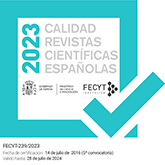The Office of the Translation of the Apostle James in the late Middle Ages: on the subject of a fragment of antiphonary found in the Cathedral of Segovia
DOI:
https://doi.org/10.3989/ceg.2011.v58.i124.243Keywords:
Apostle James, Translation Office, liturgy, plainchant, Codex Calixtinus, responsory, antiphonAbstract
The research made with regard to the music composed for the cult of the Apostle James is generally based on the Codex Calixtinus. Although the Codex is an outstanding source, it has little connection with the varied and widespread Jacobean lyrical expressions in the Iberian Peninsula throughout in the late Middle Ages. The discovery of this thirteenth-century antiphonary fragment from the Office of the Translation of St James in the cathedral of Segovia, will provide a glimpse, for the first time, of a part of the musical corpus compiled for the feast of St. James in the Middle Ages. The analysis presented here explores the applicability of modal, melodic and textual structures and their relationships with other repertoires, such as Gregorian chant or the works from the Calixtinus codex. At the same time, this study will examine the motives that promoted the creation of this celebration and its diffusion in the Iberian world. Moreover, it is hoped that this multi-faceted approach will attempt to date the origin of this religious service in the form that appears in the Segovia fragment, and also will detail the reasons of its reform after the Council of Trent. In conclusion, it will be compared to both the antiphonal and the responsorial series of this office, from different Spanish liturgical sources, with the aim of understanding the degree of uniformity in the transmission of its texts.
Downloads
Download data is not yet available.
Downloads
Published
2011-12-30
How to Cite
Ruiz Torres, S. (2011). The Office of the Translation of the Apostle James in the late Middle Ages: on the subject of a fragment of antiphonary found in the Cathedral of Segovia. Cuadernos De Estudios Gallegos, 58(124), 79–98. https://doi.org/10.3989/ceg.2011.v58.i124.243
Issue
Section
Articles
License
Copyright (c) 2011 Consejo Superior de Investigaciones Científicas (CSIC)

This work is licensed under a Creative Commons Attribution 4.0 International License.
© CSIC. Manuscripts published in both the printed and online versions of this Journal are the property of Consejo Superior de Investigaciones Científicas, and quoting this source is a requirement for any partial or full reproduction.All contents of this electronic edition, except where otherwise noted, are distributed under a “Creative Commons Attribution 4.0 International” (CC BY 4.0) License. You may read here the basic information and the legal text of the license. The indication of the CC BY 4.0 License must be expressly stated in this way when necessary.
Self-archiving in repositories, personal webpages or similar, of any version other than the published by the Editor, is not allowed.
















